Autonomous Robots Put to Work
Article By : Cabe Atwell
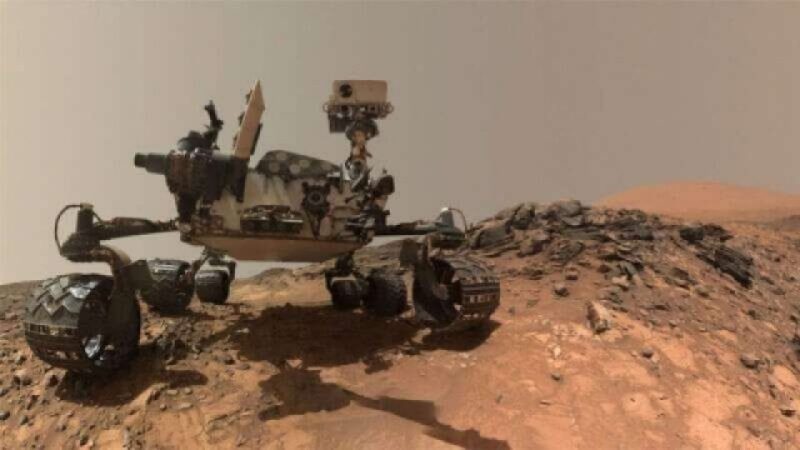
Robots aren’t exactly taking over the world, but autonomous vehicles, radio-controlled cars, and robots are becoming a common sight at many workspaces.
Robots aren’t exactly taking over the world, but autonomous vehicles, radio-controlled cars, and robots are becoming a common sight at many workspaces. From military and industry to energy and emergency services, robots are becoming part of the regular crew ─ and it’s for good reason. Here are the top five robot workers, where you’ll see them, and why.
Why robots
Technology for autonomous vehicles has increased significantly over the past decade. The robots of today are equipped with sensors that can do everything from identifying motion and excessive moisture, to notifying operators in the event of abnormal temperature fluctuations and vibration levels.
In this way, robots can help signal if what they are inspecting is about to break down, allowing crews to come in early, service machines, and prevent significant breakdowns. Comparatively, robots are also cheap. Aside from the initial purchase cost and scheduled maintenance, the costs of “hiring” robots can be much less than hiring people for 24/7 surveillance.
The industries using autonomous cars and robots
Energy
Drones play a significant role in the energy sector. For years now, the flying autonomous devices have been used to monitor the need for machine maintenance, and for security surveillance. Drones are so popular in the energy sector, they even have their own summit.
In the first report of its kind released last year, drones were found to play a significant role in the energy sector. In a survey conducted by the Energy Drone Coalition and DRONEII.com, more than 67 percent of the energy companies that responded to the survey said they used drones in energy operations. Approximately 50% of companies that participated in the survey said they used drones in-house. Most of the companies even admitted to having a drone division/department.
Drones equipped with infrared technologies seemed to be key in energy operations. Energy companies said they used drones primarily for maintenance and facility inspection, though they also indicated interest in R&D to explore the use of expanding drone use into other areas of operations.
Emergency Response
Emergency response units have also started using autonomous robots. For example, Mitsubishi Heavy Industries just created an autonomous firefighting robot that drives itself to fires that would otherwise be inaccessible to human firefighters. The autonomous vehicle consists of two main robots connected by hose. The robots operate as a water cannon and a hose extension for fighting fires.
The role of autonomous robots for emergency response is also like to expand. In a paper published by the National Center for Biotechnology Information (NCBI), researchers looked at the use of autonomous robots for use in natural disaster relief in Indonesia. In the case study, researchers looked at the potential for using autonomous robots with facial recognition, backpropagation neural networks, and camera/video feed to find and assist victims of natural disasters in Indonesia.
Military
Autonomous robots are also getting heavy usage in military applications, mostly for surveillance purposes. Regardless of cost, the military can send a robot into many dangerous, high-stakes scenarios without having to risk a soldier’s life. Robotic devices can also be used for gaining discreet intelligence.
SDR Tactical Robots is a company that specializes in tactical robot development for military use. It advertises the use of autonomous and radio-controlled cars for tactical surveillance, hostage negotiations, HAZMAT investigation, and explosive ordnance disposal (EOD).
The military also relies on a number of other autonomous robotics, such as drones, and drones that deploy yet more drones.
Industrial Sector
The industrial sector is also beginning to use autonomous robots for machine surveillance and security. One example includes Spot Mini, a creepy looking robo-dog that has onboard cameras and sensors for added surveillance at job sites.
Drones are also used within the industrial sector to monitor the health of the machinery and survey difficult areas to access otherwise. Applications include mining, seaports, oil and gas, and a number of other industrial facilities with lots of hard-to-reach places and many things that could go wrong.
Though not used for security or surveillance purposes, Amazon is leading the front in autonomous shipping robot technology. Amazon relies on more than 800 robots for its impressive semi-automated shipment fulfillment operations.
Top Five Autonomous Robots for Job-Site Surveillance
There are literally hundreds of robotic devices on the market. Still, a handful stand out. Here are the five top autonomous robots you could see at a shopping mall or park near you.
1. K5 Robot Used for Security
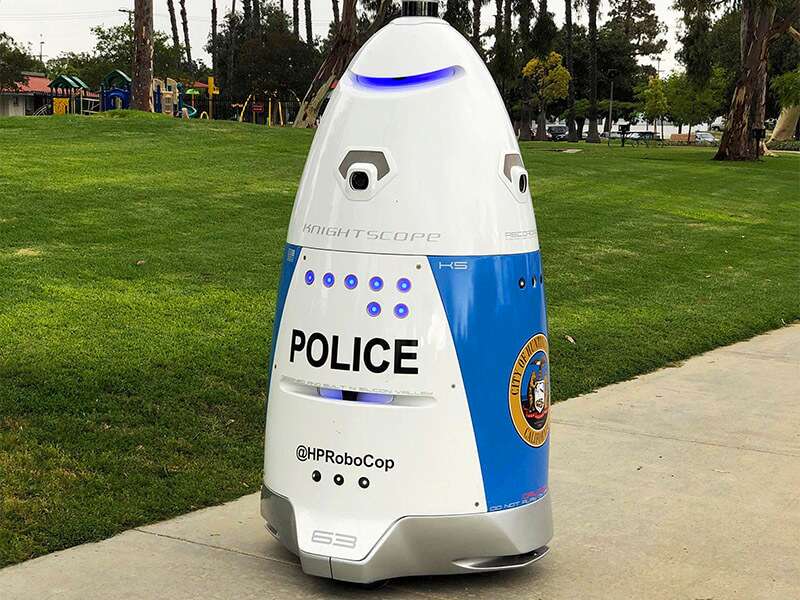
K5 robot is used to police Huntington Park in California. (Source: Knightscope)
The K5 robot by Knightscope is one autonomous robot you’re going to be seeing everywhere. The five-foot-tall robot that looks a lot like R2-D2 has already been deployed in a number of places. The police department of Huntington Park, California, deployed the K5 robot at Huntington Park, stating they did so to make sure the public feels safe at the site, no matter the time of day. The K5 is also being used for security in a number of other applications, including shopping centers, hospitals, casinos, banks, parking lots, public areas, apartment complexes, and general worksites.
The K5 robots can survey any area they are programmed to patrol. The robot moves at 3 mph and uses LIDAR sensors every 25 milliseconds to search for suspicious activity. The robot also comes equipped with 360-degree cameras to monitor a particular precinct at all times. It can also be set up to respond to a number of visual or auditory triggers, such as sudden movement, flashes of light, and questionable noises. All video recordings made by the device come stamped with GPS coordinates. The robots also function as a one-way speaker. If something is wrong, a frightened pedestrian can press a button on the robot to talk to a live security guard.
It doesn’t just end there either. The robot can record chatter and can listen for particular keywords that could indicate a possible crime. The robots learn over time as well, and can recognize that sudden movement at 3:00 a.m. is more of a cause for concern than motion at 9:00 a.m. during rush hour. It can also detect abnormal motion, such as someone crouching next to a car. Lastly, the K5 is equipped with safety features. If someone tries to push the robot, or disable it, it will notify security, the police, or emit a high-pitched alarm. Even approaching the robot will alert the authorities.
2. Spot, The Friendly Neighborhood Dog-Robot
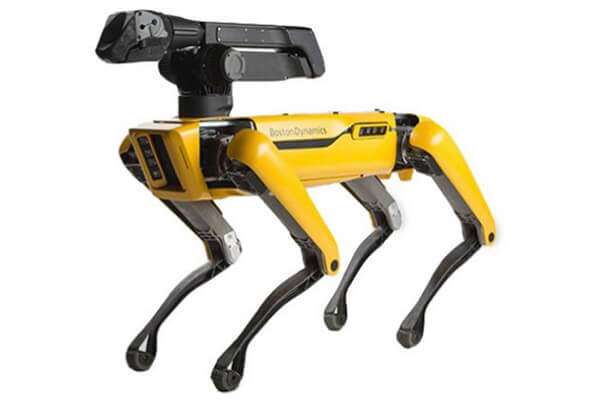
Spot, the friendly neighborhood dog-robot. (Source: Boston Dynamics)
Spot, the friendly neighborhood dog-robot, has gotten a lot of attention lately. It looks kind of like a terrifying alien dog, but it can help with worksite surveillance, according to manufacturer Boston Dynamics.
Spot can autonomously surveille areas that are mapped out. If a map of the area has not been uploaded to the robot’s computer, operators can use a kind of handheld video game remote console to control the dog. Spot doesn’t have any of the security features of K5, but it is sort of fun to have a robotic dog around. The robot comes with a number of sensors that give it 3D imaging capabilities. A robotic arm can also be added to the robot, which gives it the ability to pick up objects and open doors. This could be useful for sorting tools or (slowly) picking up debris on-site. Spot can also withstand kicks and was programmed to complete any programmed tasks despite distractions.
It is unclear how helpful a robot like Spot would be for surveilling industrial areas since it is only semi-autonomous, but it is certainly a crowd favorite.
3. GuardBot, A Surveillance Robot for Military
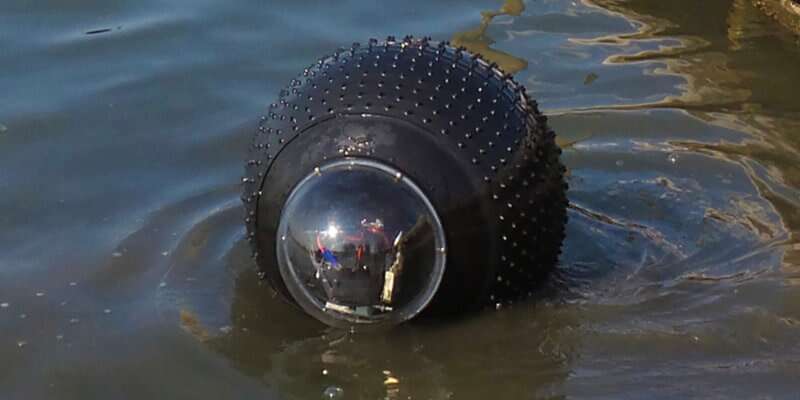
GuardBot, a surveillance robot for military. (Source: GuardBot)
Though not yet deployed commercially, GuardBot is another surveillance robot that could be coming to a military unit very soon. The robot looks like a simple yoga ball, but it is equipped with two surveillance cameras, microphones, GPS tracking, and a battery that keeps the autonomous ball powered for 25 hours on a single charge. The robots come in various sizes, from 5 inches to 7 feet in diameter. The real kicker is that the robot can be deployed anywhere. It can traverse any terrain, from sand dunes and snow to uneven gravel and dirt. The ball even swims at 3 mph.
The robot is currently being tested by the military for use in future deployments.
4. U.S. Air Force’s Newest Drone: The XQ-58A
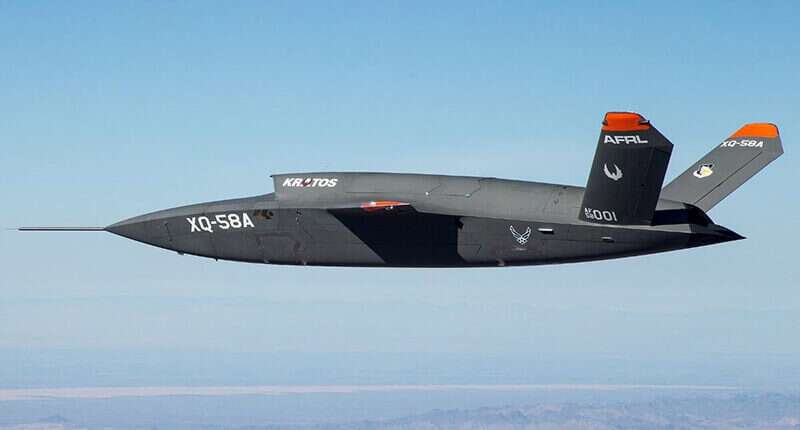
The U.S. Air Force’s newest drone that can both surveille the skies and counter-attack. (Source: Wikipedia)
Drones lead the front when it comes to autonomous devices for surveillance across industrial applications. Still, nothing quite compares to the U.S. Air Force’s newest drone: the XQ-58A Valkyrie demonstrator – a long-range, subsonic, unmanned combat air vehicle that can both surveille the skies and counter-attack. Can you say “sweet”?
The drone just completed its first flight in March 2019, and offers an arsenal of features previously only dreamed about in drone technology. The low-cost drones will be used for surveillance purposes above deployed troops. It also has a stealthy radar design that both makes it difficult for enemy aircraft to find, and also enables it to pair with the F-35 Joint Strike Fighter for assistance in combat situations.
The drone will follow enemy strikes to prevent attacks from hitting manned aircraft, and will also counter-attack, as it is able to follow enemy positions and aircraft.
For less high-stakes scenarios, check out the drones from Airobotics. The company offers UAV applications for every industry.
5. SMP Roving Robots
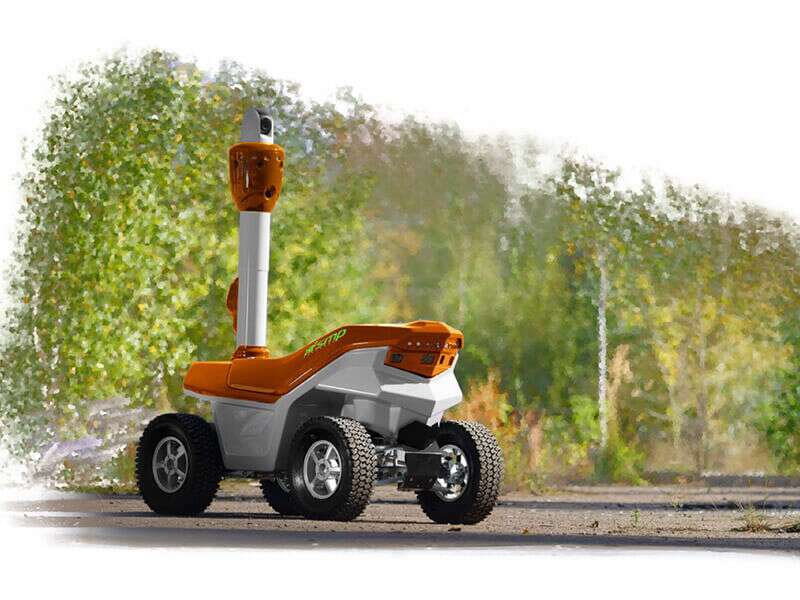
Roving robots, like this one from SMP, are popular in the industrial sector. (Source: SMP Robotics)
Roving robots are also popular in the industrial sector. There are a number of companies that make quality roving bots. One of the most interesting is the S5 series by SMP Robotics. Similar to the K5, these autonomous miniature cars were built for surveillance.
SMP advertises that the S5.2 series robot can be used for policing, patrolling the fence line, night patrolling, mining site security, open-water coastal surveillance, security of infrastructure, surveillance of energy and industrial infrastructure, and security at warehouses, parking lots, vacant land, and apartment complexes.
The robot features autonomous movement, obstacle avoidance, low-light 360-degree panoramic video, human and facial recognition, PTZ cameras, motion tracking, ONVIF video, and automatic charging.
Final Word
Robotic technology only continues to advance. Though there are plenty of robots available for commercial deployment today, we can easily imagine what the autonomous robots of tomorrow will look like and how they will help us make public spaces and job sites even safer in the future.